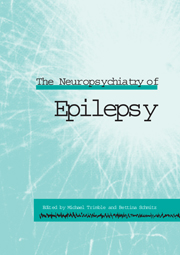Book contents
- Frontmatter
- Contents
- List of contributors
- Part I Background
- Part II Clinical aspects
- 4 The psychiatry of idiopathic generalized epilepsy
- 5 Epilepsy and learning disorders
- 6 Subtle cognitive and behavioural effects of epilepsy
- 7 Aggression and epilepsy
- 8 Epilepsy and suicide: a neuropsychiatric analysis
- 9 Postictal psychoses, revisited
- Part III Cognitive aspects
- Part IV Nonepileptic attacks
- Part V Treatment complications
- Part VI Treatment
- Index
8 - Epilepsy and suicide: a neuropsychiatric analysis
Published online by Cambridge University Press: 05 October 2010
- Frontmatter
- Contents
- List of contributors
- Part I Background
- Part II Clinical aspects
- 4 The psychiatry of idiopathic generalized epilepsy
- 5 Epilepsy and learning disorders
- 6 Subtle cognitive and behavioural effects of epilepsy
- 7 Aggression and epilepsy
- 8 Epilepsy and suicide: a neuropsychiatric analysis
- 9 Postictal psychoses, revisited
- Part III Cognitive aspects
- Part IV Nonepileptic attacks
- Part V Treatment complications
- Part VI Treatment
- Index
Summary
Introduction
According to eight reports, death by suicide occurs in 5% of patients with epilepsy, compared with 1.4% in the general population (Matthews and Barabas, 1981). Based on four reports, the four – to fivefold increase in suicides among patients with epilepsy over the rate in the general population is magnified to approximately 25–fold among patients with temporal lobe epilepsy (Barraclough, 1987). In a Danish study covering 14 years (Henriksen et al., 1970), 164 of 2763 patients with epilepsy died (an excess mortality rate of 273% compared to the number of deaths expected in the general population). While epilepsy was the cause of death in 26%, suicide was the cause of death in 20% (an excess mortality rate of 300%) at an average age at death of 32 years. For studies of an association between epilepsy and suicide to be statistically valid, the cohort must be standardized by age and sex, according to Stenager and Stenager (1992); most studies have not met these standards. The same authors pointed out that the variety of forms of epilepsy necessitates an examination of each syndrome singly for risk of suicide. Their second point is very significant, because the data available indicate that suicide is associated particularly with temporal lobe epilepsy.
Suicide and attempted suicide
Murphy (1994) points out that it is important to distinguish between suicide and attempted suicide. Differences between epileptic patients who attempt suicide and those who complete the act are not established.
- Type
- Chapter
- Information
- The Neuropsychiatry of Epilepsy , pp. 107 - 116Publisher: Cambridge University PressPrint publication year: 2002
- 9
- Cited by



